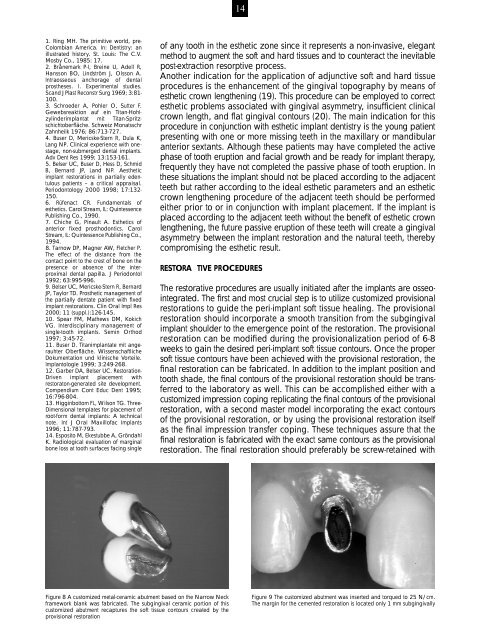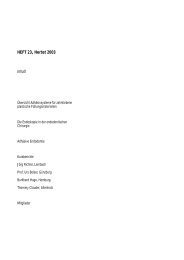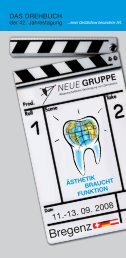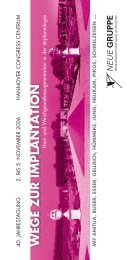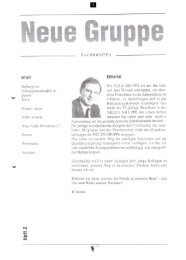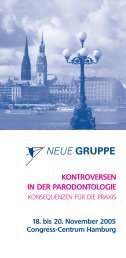Heft 19 - Herbst 2001.pdf - Neue Gruppe
Heft 19 - Herbst 2001.pdf - Neue Gruppe
Heft 19 - Herbst 2001.pdf - Neue Gruppe
Erfolgreiche ePaper selbst erstellen
Machen Sie aus Ihren PDF Publikationen ein blätterbares Flipbook mit unserer einzigartigen Google optimierten e-Paper Software.
1. Ring MH. The primitive world, pre-<br />
Colombian America. In: Dentistry: an<br />
illustrated history. St. Louis: The C.V.<br />
Mosby Co., <strong>19</strong>85: 17.<br />
2. Brånemark P-I, Breine U, Adell R,<br />
Hansson BO, Lindström J, Olsson A.<br />
Intraosseous anchorage of dental<br />
p rostheses. I. Experimental studies.<br />
Scand J Plast Reconstr Surg <strong>19</strong>69; 3:81-<br />
100.<br />
3. Schroeder A, Pohler O, Sutter F.<br />
G e w e b s reaktion auf ein Ti t a n - H o h lzylinderimplantat<br />
mit Ti t a n - S p r i t zschichtoberfläche.<br />
Schweiz Monatsschr<br />
Zahnheilk <strong>19</strong>76; 86:713-727.<br />
4. Buser D, Mericske-Stern R, Dula K,<br />
Lang NP. Clinical experience with onestage,<br />
non-submerged dental implants.<br />
Adv Dent Res <strong>19</strong>99; 13:153-161.<br />
5. Belser UC, Buser D, Hess D, Schmid<br />
B, Bern a rd JP, Land NP. Aesthetic<br />
implant restorations in partially edentulous<br />
patients – a critical appraisal.<br />
Periodontology 2000 <strong>19</strong>98; 17:132-<br />
150.<br />
6. Rüfenact CR. Fundamentals of<br />
esthetics. Carol Stream, IL: Quintessence<br />
Publishing Co., <strong>19</strong>90.<br />
7. Chiche G, Pinault A. Esthetics of<br />
anterior fixed prosthodontics. Caro l<br />
S t ream, IL: Quintessence Publishing Co.,<br />
<strong>19</strong>94.<br />
8. Tarnow DP, Magner AW, Fletcher P.<br />
The effect of the distance from the<br />
contact point to the crest of bone on the<br />
p resence or absence of the interp<br />
roximal dental papilla. J Periodontol<br />
<strong>19</strong>92; 63:995-996.<br />
9. Belser UC, Mericske-Stern R, Bernard<br />
JP, Taylor TD. Prosthetic management of<br />
the partially dentate patient with fixed<br />
implant restorations. Clin Oral Impl Res<br />
2000; 11 (suppl.):126-145.<br />
10. Spear FM, Mathews DM, Kokich<br />
VG. Interd i s c i p l i n a ry management of<br />
single-tooth implants. Semin Ort h o d<br />
<strong>19</strong>97; 3:45-72.<br />
11. Buser D. Titanimplantate mit angerauhter<br />
Oberfläche. Wi s s e n s c h a f t l i c h e<br />
Dokumentation und klinische Vo rt e i l e .<br />
Implantologie <strong>19</strong>99; 3:249-268.<br />
12. Garber DA, Belser UC. Restoration-<br />
Driven implant placement with<br />
restoraton-generated site development.<br />
Compendium Cont Educ Dent <strong>19</strong>95;<br />
16:796-804.<br />
13. Higginbottom FL, Wilson TG. Three-<br />
Dimensional templates for placement of<br />
ro o t - f o rm dental implants: A technical<br />
note. Int J Oral Maxillofac Implants<br />
<strong>19</strong>96; 11:787-793.<br />
14. Esposito M, Ekestubbe A, Gröndahl<br />
K. Radiological evaluation of marginal<br />
bone loss at tooth surfaces facing single<br />
14<br />
of any tooth in the esthetic zone since it re p resents a non-invasive, elegant<br />
method to augment the soft and hard tissues and to counteract the inevitable<br />
post-extraction resorptive pro c e s s .<br />
Another indication for the application of adjunctive soft and hard tissue<br />
p ro c e d u res is the enhancement of the gingival topography by means of<br />
esthetic crown lengthening (<strong>19</strong>). This pro c e d u re can be employed to corre c t<br />
esthetic problems associated with gingival asymmetry, insufficient clinical<br />
c rown length, and flat gingival contours (20). The main indication for this<br />
p ro c e d u re in conjunction with esthetic implant dentistry is the young patient<br />
p resenting with one or more missing teeth in the maxillary or mandibular<br />
anterior sextants. Although these patients may have completed the active<br />
phase of tooth eruption and facial growth and be ready for implant therapy,<br />
f requently they have not completed the passive phase of tooth eruption. In<br />
these situations the implant should not be placed according to the adjacent<br />
teeth but rather according to the ideal esthetic parameters and an esthetic<br />
c rown lengthening pro c e d u re of the adjacent teeth should be perf o rm e d<br />
either prior to or in conjunction with implant placement. If the implant is<br />
placed according to the adjacent teeth without the benefit of esthetic cro w n<br />
lengthening, the future passive eruption of these teeth will create a gingival<br />
a s y m m e t ry between the implant restoration and the natural teeth, there b y<br />
c o m p romising the esthetic re s u l t .<br />
R E S T O R ATIVE PROCEDURES<br />
Figure 8 A customized metal-ceramic abutment based on the Narrow Neck<br />
framework blank was fabricated. The subgingival ceramic portion of this<br />
customized abutment re c a p t u res the soft tissue contours created by the<br />
provisional restoration<br />
The restorative pro c e d u res are usually initiated after the implants are osseointegrated.<br />
The first and most crucial step is to utilize customized pro v i s i o n a l<br />
restorations to guide the peri-implant soft tissue healing. The pro v i s i o n a l<br />
restoration should incorporate a smooth transition from the subgingival<br />
implant shoulder to the emergence point of the restoration. The pro v i s i o n a l<br />
restoration can be modified during the provisionalization period of 6-8<br />
weeks to gain the desired peri-implant soft tissue contours. Once the pro p e r<br />
soft tissue contours have been achieved with the provisional restoration, the<br />
final restoration can be fabricated. In addition to the implant position and<br />
tooth shade, the final contours of the provisional restoration should be transf<br />
e rred to the laboratory as well. This can be accomplished either with a<br />
customized impression coping replicating the final contours of the pro v i s i o n a l<br />
restoration, with a second master model incorporating the exact contours<br />
of the provisional restoration, or by using the provisional restoration itself<br />
as the final impression transfer coping. These techniques assure that the<br />
final restoration is fabricated with the exact same contours as the pro v i s i o n a l<br />
restoration. The final restoration should preferably be scre w - retained with<br />
Figure 9 The customized abutment was inserted and torqued to 25 N/cm.<br />
The margin for the cemented restoration is located only 1 mm subgingivally


